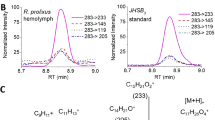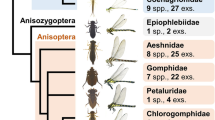Abstract
JUVENILE hormone acts directly on individual cells of the insect and ensures the appearance and maintenance of those structural features which characterize the larval stage1. Because this hormone is merely controlling the manifestation of certain genetically determined characters which are latent in the epidermal cells, I predicted that “it would be by no means impossible for a variety of chemical substances to exert such an effect—just as a wide variety of chemicals can exert an “anti-bar” effect in bar-eyed mutants of Drosophila”2. It is, however, still unknown whether the site of action of the hormone is the cytoplasm or the nucleus. In a survey of the mode of action of growth hormones in insects I suggested that the juvenile hormone could be “concerned in the regulation of permeability relations within the cell—in such a way that the gene-controlled enzyme system responsible for larval characters is brought increasingly into action when the juvenile hormone is present”3.
This is a preview of subscription content, access via your institution
Access options
Subscribe to this journal
Receive 51 print issues and online access
$199.00 per year
only $3.90 per issue
Buy this article
- Purchase on Springer Link
- Instant access to full article PDF
Prices may be subject to local taxes which are calculated during checkout
Similar content being viewed by others
References
Wigglesworth, V. B., Quart. J. Microsc. Sci., 79, 91 (1936).
Wigglesworth, V. B., Appendix to Schmialek, P., Z. Naturforsch., 16b, 461 (1961).
Wigglesworth, V. B., Symp. Soc. Exp. Biol., 11, 204 (1957).
Wigglesworth, V. B., J. Insect Physiol. (in the press).
Schneiderman, H. A., Krisnakumaran, A., Kulkarni, V. G., and Friedman, L., J. Insect. Physiol., 11, 1641 (1965).
Yamamoto, R. T., and Jacobson, M., Nature, 196, 208 (1962).
Dahm, K. H., Röller, H., and Trost, B. M., Life Sci., 7, 129 (1968).
Röller, H., and Dahm, K. H., Recent Progress in Hormone Research, 24 (in the press).
Barrall, E. M., Porter, R. S., and Johnson, J. F., J. Chromatog., 21, 392 (1966).
Bowers, W. S., and Thompson, M. J., Science, 142, 1469 (1963).
Willmer, E. N., Biol Rev., 36, 368 (1961).
Bowers, W. S., Thompson, M. J., and Uebel, E. C., Life Sci., 4, 2323 (1965).
Baumann, G., J. Insect Physiol., 14, 1365 (1968).
Author information
Authors and Affiliations
Rights and permissions
About this article
Cite this article
WIGGLESWORTH, V. Chemical Structure and Juvenile Hormone Activity. Nature 221, 190–191 (1969). https://doi.org/10.1038/221190a0
Received:
Issue Date:
DOI: https://doi.org/10.1038/221190a0
Comments
By submitting a comment you agree to abide by our Terms and Community Guidelines. If you find something abusive or that does not comply with our terms or guidelines please flag it as inappropriate.



